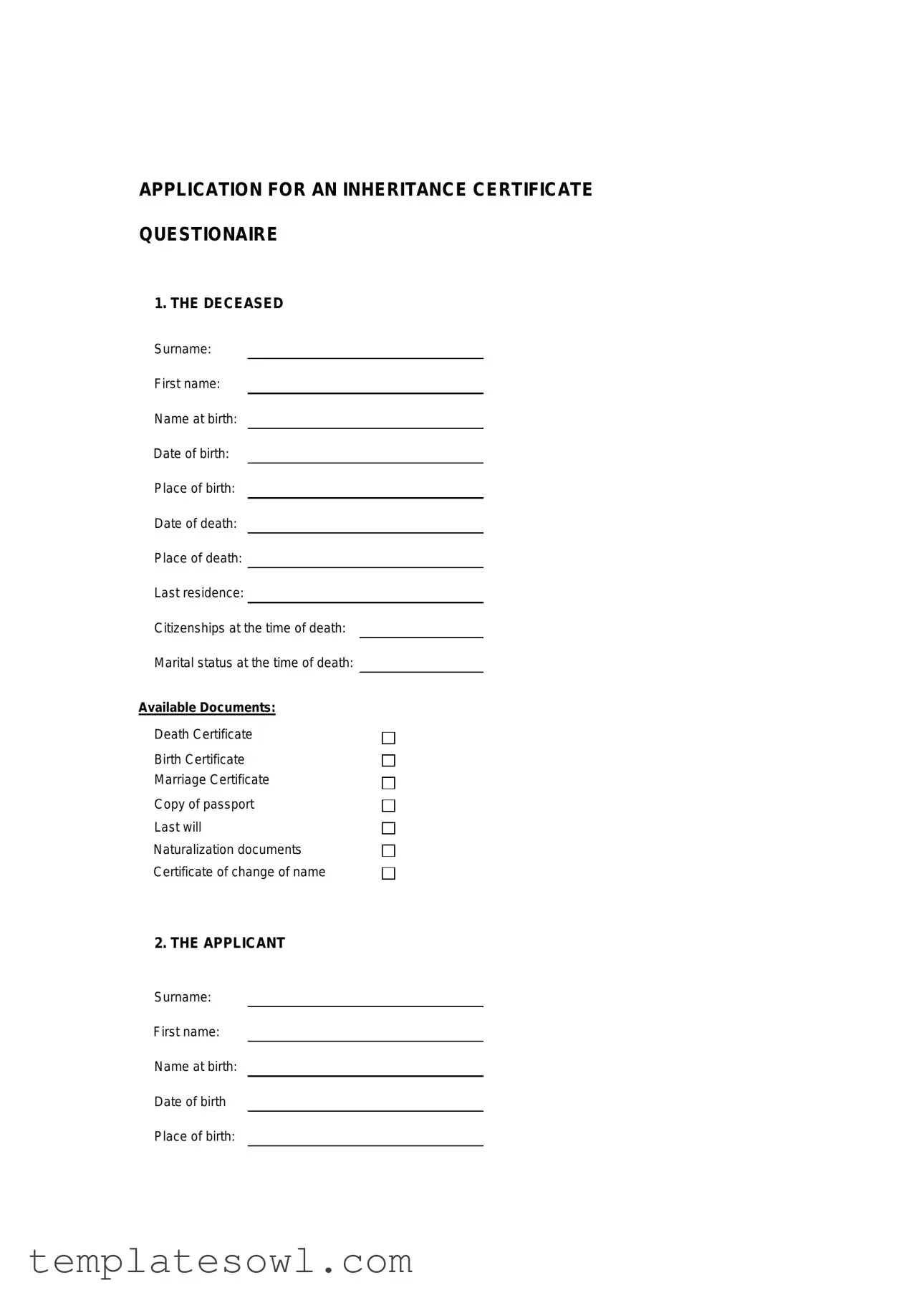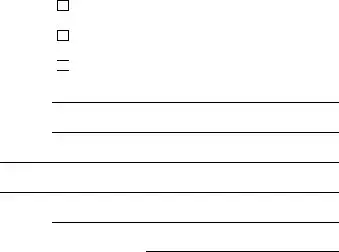APPLICATION FOR AN INHERITANCE CERTIFICATE
QUESTIONAIRE
1. THE DECEASED
Surname:
First name:
Name at birth:
Date of birth:
Place of birth:
Date of death:
Place of death:
Last residence:
Citizenships at the time of death:
Marital status at the time of death:
Available Documents:
|
Death Certificate |
□ |
|
Birth Certificate |
|
□ |
|
Marriage Certificate |
|
□ |
|
Copy of passport |
|
□ |
|
Last will |
|
□ |
|
|
|
Naturalization documents |
□ |
|
Certificate of change of name |
|
□ |
|
|
|
2. THE APPLICANT |
|
|
Surname: |
|
|
|
First name: |
|
|
Name at birth: |
|
|
Date of birth |
|
|
Current Address:
Telephone:
Citizenships:
Valid Passport / ID / Drivers´s license No.:
The deceased was my:
3. TESTAMENTARY DISPOSITIONS
Is there any last will/contract of Inheritnace or Trust?
Last will dated:
Probated by the court in: |
|
|
|
date: |
|
|
file number: |
|
I am appointed as only heir |
|
□ |
|
|
|
Apart from me the following heirs were appointed:
a)Surname:
First names:
Date of birth:
Place of birth:
Date of death:
Place of death:
Address:
Family relation to the deceased:
b)Surname:
First names:
Date of birth:
Place of birth:
Date of death:
Place of death:
Address:
Family relation to the deceased:
c)Surname:
First names:
Date of birth:
Place of birth:
Date of death:
Place of death:
Address:
Family relation to the deceased:
If more, please continue on a separate page.
4. MARRIAGES
The deceased was single. |
□ |
|
The deceased was married only once. □
The deceased was a widow/widower. □
The deceased was married ____ times.□
a)The first marriage with:
Surname:
First name:
Name at birth:
Date of birth:
Place of birth:
Last address
Date and place of wedding:
The first common residence after the marriage was in
The marriage was divorced by the decree of _________ (Court) in ____________ on the _______________
Citizenships of the deceased at the time of the first marriage:
Citizenships of the spouse at the time of the first marriage:
Did the deceased enter into a special agreement on his martial property regime?
b)The second marriage with:
Surname:
First name:
Name at birth:
Date of birth:
Place of birth:
Last address
Date and place of wedding:
The first common residence after the marriage was in
The marriage was divorced by the decree of __________ (Court) in ____________ on the ______________
Citizenships of the deceased at the time of the first marriage:
Citizenships of the spouse at the time of the first marriage:
Did the deceased enter into a special agreement on his martial property regime?
5.CHILDREN OF THE DECEASED
a)Child from the _____ marriage
Surname
First name:
Name at birth:
Date of birth:
Place of birth:
Date of death:
Place of death:
Address:
b) Child from the ____ marriage
Surname
First name:
Name at birth:
Date of birth:
Place of birth:
Date of death:
Place of death:
Address:
c)Child from the ____ marriage
Surname
First name:
Name at birth:
Date of birth:
Place of birth:
Date of death:
Place of death:
Address:
d)Child from the ____ marriage
Surname
First name:
Name at birth:
Date of birth:
Place of birth:
Date of death:
Place of death:
Address:
6.PARENTS OF THE DECEASED
a)Father of the deceased:
Surname
First name:
Name at birth:
Date of birth:
Place of birth:
Date of death:
Place of death:
Last Address:
b)Mother of the deceased
Surname
First name:
Name at birth:
Date of birth:
Place of birth:
Date of death:
Place of death:
Last Address:
Did the parents of the deceased had other children than the deceased? (If yes, please give details on a separate page)
Did the parents adopt any children?
Did the parents have children born out of wedlock?
Did one parent survived the deceased?
7. MISCELLANEOUS
My co-heirs agree to my application for a common certificate
of inheritance also on their behalf |
□ |
|
All the heirs a re willing to accept the inheritance |
□ |
|
A Lawsuit I pending in this matter about the right to inherit□

The value of the inheritance in Germany is approximately:
To whom shall the court send the inheritance certificate?
Does the inheritance include land in Germany?
Does the inheritance include bank account?
Does the inheritance includes a registered company?
Do you need the certificate of inheritance for restitution or pension matters?









